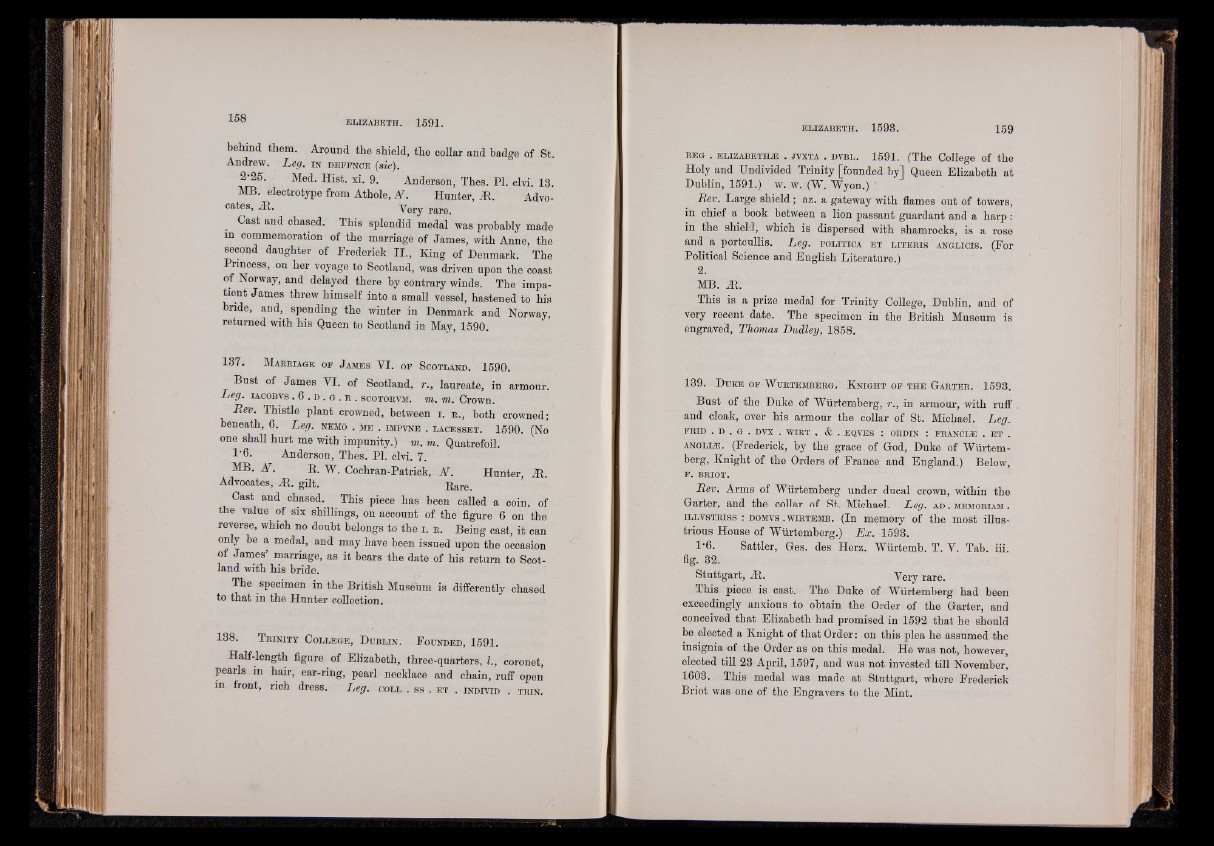
behind them. Around the shield, the collar and badge of St.
Andrew. Leg. i n d e f e n c e (sic).
2-25. Med. Hist. xi. 9. Anderson, Thes. PI. clvi. 13.
MB. electrotype from Athole, AT. Hunter, At. Advocates,
At. Very rare.
Cast and chased. This splendid medal was probably made
in commemoration of the marriage of James, with Anne, the
second daughter of Frederick II., King of Denmark. The
Princess, on her voyage to Scotland, was driven upon the coast
of Norway, and delayed there by contrary winds. The impatient
James threw himself into a small vessel, hastened to his
bride, and, spending the winter in Denmark and Norway,
returned with his Queen to Scotland in May, 1590.
137. M a e r i a g e o p J a m e s VI. o p S c o t l a n d . 1590.
Bust of James VI. of Scotland, r., laureate, in armour.
Leg. i a c o b v s . 6 . d . g . b . s c o to b vm . to. m. Crown.
Rev. Thistle plant crowned, between i. e., both crowned;
beneath, 6. Leg. n em o . m e . im p v n e . l a c e s s e t . 1590. (No
one shall hurt me with impunity.) to. to. Quatrefoil.
1*6. Anderson, Thes. PI. clvi. 7.
MB. Ar. B. W. Cochran-Patrick, AC Hunter, At.
Advocates, At. gilt. Rare.
Cast and chased. This piece has been called a coin, of
the value of six shillings, on account of the figure 6 on the
reverse, which no doubt belongs to the i. e. Being cast, it can
only be a medal, and may have been issued upon the occasion
of James’ marriage, as it bears the date of his return to Scotland
with his bride.
The specimen in the British Museum is differently chased
to that in the Hunter collection.
188. T r i n i t y C o l l e g e , D u b l i n . F o u n d e d , 1591.
Half-length figure of Elizabeth, three-quarters, I., coronet,
pearls in hair, ear-ring, pearl necklace and chain, ruff open
in front, rich dress. Leg. c o l l . ss . e t . in d I v id . t e i n .
BEG . ELIZABETHS . j v x t a . d v b l . 1591. (The College of the
Holy and Undivided Trinity [founded by] Queen Elizabeth at
Dublin, 1591.) w. w. (W. Wyon.) 1
Rev. Large shield; az. a gateway with flames out of towers,
in chief a book between a lion passant guardant and a harp:
in the shield, which is dispersed with shamrocks, is a rose
and a portcullis. Leg. p o l i t i c a e t l i t e e i s a n g l i c i s . (For
Political Science and English Literature.)
2.
MB. At.
This is a prize medal for Trinity College, Dublin, and of
very recent date. The specimen in the British Museum is
engraved, Thomas Dudley, 1858.
139. D u k e o p W u e t e m b e e g . K n i g h t o f t h e G a e t e e . 1593.
Bust of the Duke of Wiirtemberg, r., in armour, with ruff
and cloak, over his armour the collar of St. Michael. Leg.
FEID . D . G . DVX . WIET . & . EQVES : OEDIN : FEAN C IS . ET .
a n g l l® . (Frederick, by the grace of God, Duke of Wiirtem-
berg, Knight of the Orders of France and England.) Below,
F. BEIOT.
Rev. Arms of Wiirtemberg under ducal crown, within the
Garter, and the collar of St. Michael. Leg. a d . m em o e iam .
i l l v s t e i s s : d om v s .w i e t e m b . (In memory of the most illustrious
House of Wiirtemberg.) Ex. 1593.
P6. Sattler, Ges. des Herz. Wiirtemb. T. V. Tab. iii.
fig. 32.
Stuttgart, At. Very rare.
This piece is cast. The Duke of Wiirtemberg had been
exceedingly anxious to obtain the Order of the Garter, and
conceived that Elizabeth had promised in 1592 that he should
be elected a Knight of that Order: on this plea he assumed the
insignia of the Order as on this medal. He was not, however,
elected till 23 April, 1597, and was not invested till November,
1603. This medal was made at Stuttgart, where Frederick
Briot was one of the Engravers to the Mint.